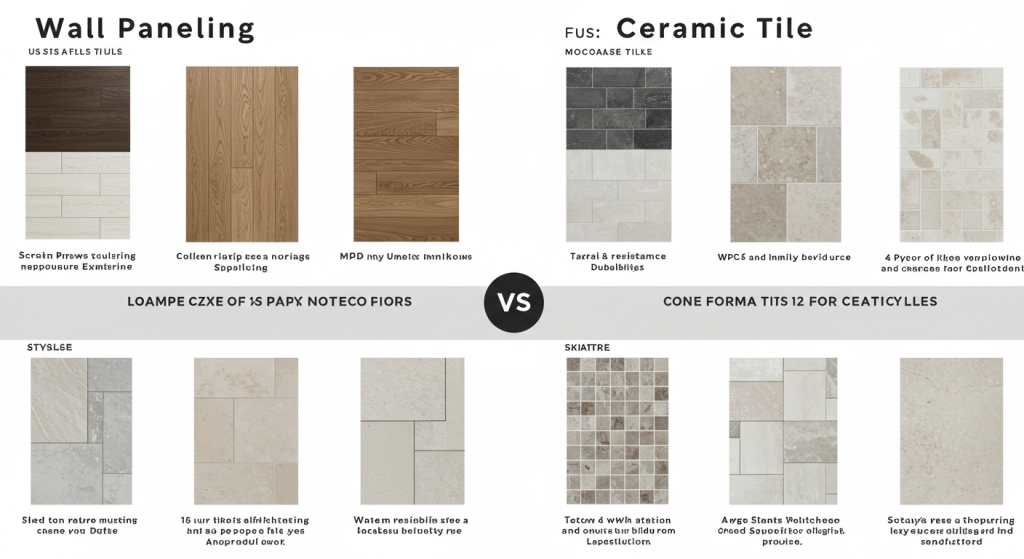PVC Wall Panel Vs Ceramic Tiles Comparison: Key Differences
What are PVC Wall Panels?
PVC wall panels are coverings manufactured out of polyvinyl chloride (PVC). These panels are available as tongue-and-groove segments or in larger sheets, which are more convenient to install grouting-free. One panel weighs around 0.5 kilograms; hence, the installation requires no specialized labor as it is a one-person task.
Aesthetically achievable without substantial renovation work include marble and wood grain finishes. Embellishments and high-gloss options enhance water-resistance, making them suitable for bathrooms and kitchens.
Ceramic tiles undergo firing at high temperatures, which provides durability and strength; thus need natural materials such as clay, feldspar, quartz, and silica are shaped into porous, limited shapes will later baked into water-resistant slabs.
Different types of these tiles include glazed ceramic tiles and porcelain tiles; the latter is denser due to undergoing higher temperatures and meeting ISO ASTM standards with less than 0.5 absorption. Porcelains are best water resistant and enduring under heavy use spaces bearing stringent standards powerful bond adhesive.
Installation: DIY Vs Pro
PVC Panels
DIY friendly—click lock or adhesive marine grade silicone, requires no grout
Can complete over existing tile or plasterboard— finishes in 4–8 hrs
Ceramic Tiles
Surface prep, adhesive application, precise placement, grouting, and curing take multiple days of work.
Often requires a professional tiler for larger formats.
Key Differences Between PVC Wall Panels and Ceramic Tiles
Choosing wall materials such as PVC wall panel vs Ceramic tiles comparison for spaces like bathrooms and kitchens requires understanding the differences between these two materials in terms of their installation process, aesthetics, maintenance, durability, cost, and environmental considerations. This article aims to clarify differences so that informed decisions can be made based on individual project requirements.
1. Material Composition
Wall panels are composed of polyvinyl chloride, which is a lightweight plastic known for flexibility and water resistance. These panels are available in the form of tongue-and-groove boards or large sheets, which simplify handling during installation.
The raw materials for ceramic tiles include clay, feldspar, quartz, and silica, which are molded and subsequently fired at high temperatures for hardness and durability. Meanwhile, a subtype of ceramic tiles, porcelain tiles, is less porous and denser due to higher firing temperatures.

2. Installation
PVC Panels do not require grouting; thus, they can be directly glued or screw-fixed to existing walls. Because the panels weigh approximately 0.5 kg each, installation is straightforward enough that it only requires one person.
In contrast to PVC panel installation, Ceramic Tiles will¬ require technical knowledge and more time for tile adhesive application before rigid spacing of the tiles and grouting. For seamless installation that prevents cracking post-installation, as well as aesthetic alignment, a professional’s assistance may be needed, depending on the designs used.
3. Aesthetic Options
With regards to aesthetics focused on wood grain or marble motifs complemented with high-gloss finishes yield a stunning gloss shine display on PVC wall panels, further enhancing their appeal but lacking a realistic semblance upon close observation.
Delivering unmatched realism in color variation and texture makes the aesthetic appeal of ceramic tile unrivaled alongside modern reproduction techniques, allowing glazed stones to retain wooden textures, enabling them to maintain the classic ceramic refined feel.
4. Water Resistance and Durability
Due to their water-resistant properties, PVC panels can be utilized in spaces exposed to high levels of moisture. They are, however, more susceptible to scratches and dents from sharp impacts.
Water-resistance is a notable feature of ceramic tiles as well. Porcelain tiles have less than 0.5% water absorption as per ISO/ASTM standards, which contributes to their durability. Provided that they receive suitable maintenance over the years, porcelain tiles will retain their aesthetic due to scratch and heat resistance.
5. Maintenance
Like other plastic materials, PVC panels require no special maintenance procedures beyond light cleaning with mild detergents. There is no need for sealing PVC panel joints either. Prolonged exposure to strong sunlight or harsh chemicals can result in yellowing due to surface oxidation.
The Polish grout remains within the boundaries of the individual tile corners till it gets a chance to crawl out so it can play tag with unclaimed stains. This means that all the work needed for removing stubborn dirt is dement outside with a mold get-together. Pay attention—the described behavior does not extend too far: tiled surfaces are stain-friendly but only if you’re not trying hard enough.
6. Environmental Impact
The use of plastic PVC panels has raised concerns about their disposal and the potential VOC emissions from low-quality materials.
Ceramic tiles are made from natural resources, which increases their durability and usefulness over long periods, reducing replacement waste. However, their production involves expending tremendous amounts of energy through high-temperature firing.
When to Choose What?
Choose PVC if you want:
Reasonably priced installation.
Fast and easy do-it-yourself updates.
Washable, smeared walls are free of mold.
Select Ceramic Tiles if you have the following needs:
Precision longevity paired with heat resistance for intense, enduring wear and tear exposure
Natural stones or ornate tile mosaics for high-end finishes
A positive ecological footprint that is friendly to nature
Tips for Best Results
Waterproof tanking behind panels mandates proper joint sealing for PVC installations.
Tile grout should be hermetically sealed after application to inhibit dirt entry in <0.5–3% absorbed porcelain/ceramic tiles.
Conclusion
While PVC panels offer a lower cost alternative when compared to ceramic tiles concerning waterproofing, maintenance, and installation speed, especially around kitchen and bathroom areas, they lack in versatility where the luxury aesthetics and timeless feel outweigh the rest. Achieving your ideal wall design starts with your vision. For a sleek, modern look, opt for seamless PVC wall panel vs Ceramic tiles comparison. If you prefer something more robust and enduring, go for tiles. Here at HSCS Decor, we help make that vision a reality—contact us now for expert guidance!








